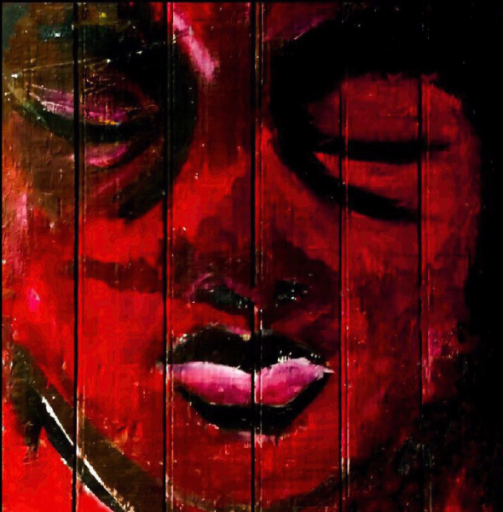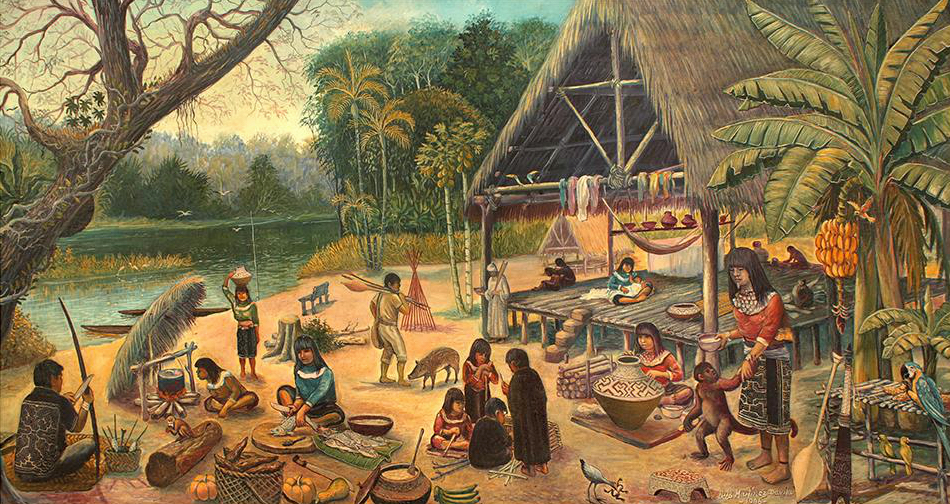
Luis Martínez Dávila, “Selva.” A portrayal of Amazonian daily life in a Shipibo village, where tradition, community, and nature coexist in harmony. It reveals the forest not as background, but as home, spirit, and sustenance.
Contemporary Amazonian Art
Part 1: Perspectives Beyond the Indigenous Legacy
The Amazon is not just a place – it is a state of being
Contemporary Amazonian art is extraordinarily diverse — a constellation of voices, visions, and sensibilities that reveal many ways of seeing the world.
It arises from a singular environment, home to artists united not by origin but by a shared bond with the region and a common identity as Amazonians.
What connects them is a deep relationship with the Amazon, shaped by lived experience and an enduring artistic commitment to its ancestral memory.
Their work draws from the vitality of nature, ancestral worldviews, myth, and the turbulent history that has shaped the region.
Within this shared identity, two creative currents unfold: one deeply rooted in Indigenous tradition and spiritual continuity, the other shaped by the transformations of modern life — in the Amazon’s cities as well as in its increasingly connected rural regions.
Contemporary Amazonian Art
Created by artists from diverse cultural backgrounds, whose connection to the Amazon is shaped by lived experience, regional belonging, and artistic commitment.
Contemporary Indigenous Art
Created by artists belonging to Indigenous communities, whose work is grounded in tradition, cosmovision, and ancestral knowledge.
These two creative currents, though born of different impulses, remain deeply connected. Sustained by the resilience of Amazonian peoples, they engage in a living dialogue between preservation and renewal, tradition and transformation, the natural world and urban experience — a dialogue grounded in stories that are both ancient and future-bound.
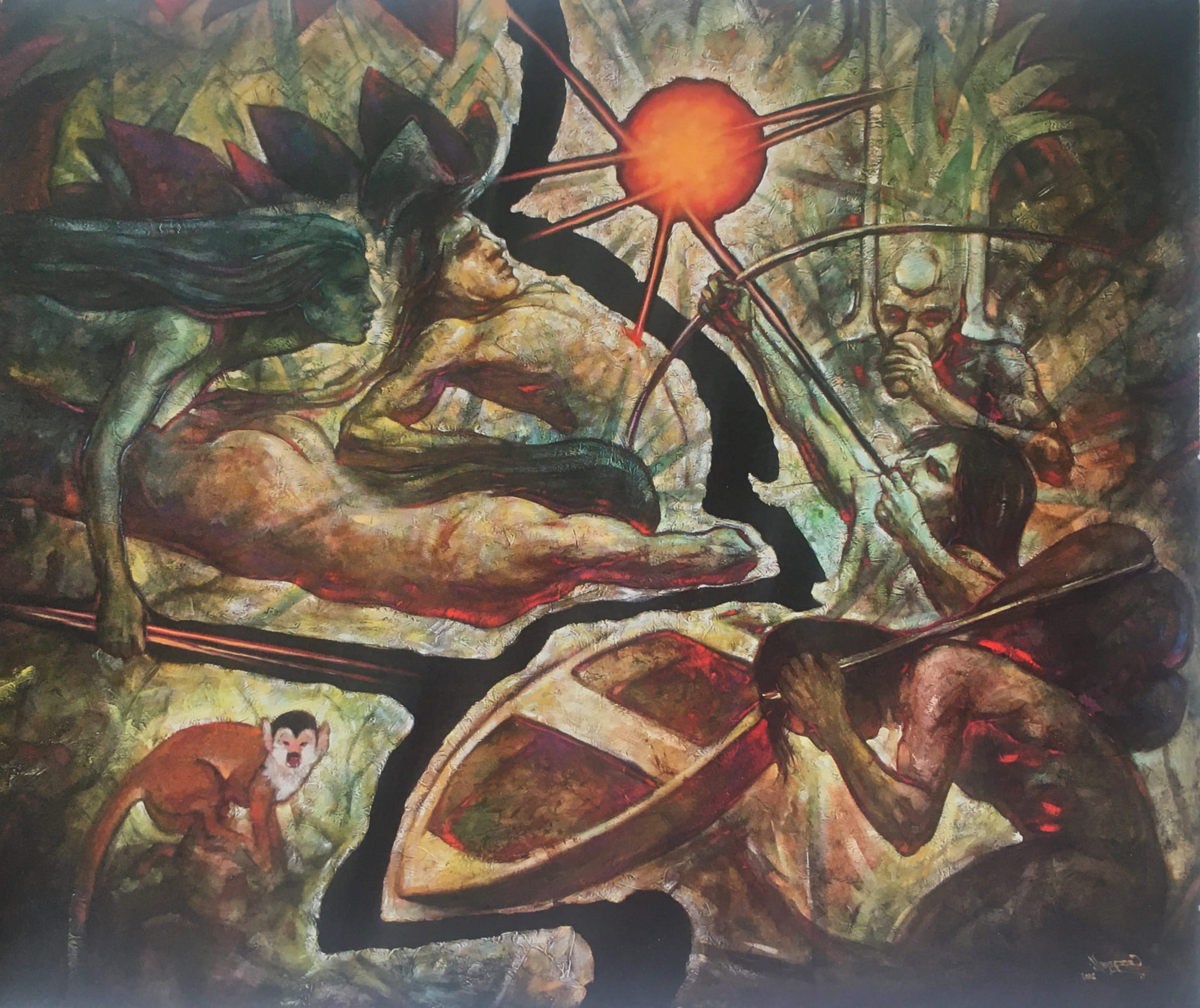
Gino Ceccarelli, Las Guerras, Through its layered figures—emerging from different eras, worlds, and mythic realms—this work reflects the tensions between pre-contact life and the influences of modernity. It evokes the ongoing physical, cultural, and spiritual negotiations that continue to shape life in the Amazon.
Ancestral Traditions — Living Legacy
Contemporary Indigenous painting carries ancestral knowledge and spiritual cosmovision into the present. It sustains the cultural integrity of Indigenous peoples while reflecting the transformations and influences that modern life brings to their traditional way of being.
Contemporary Expressions — Future Horizons
Contemporary Amazonian art also explores themes such as spirituality, myth, and legend — but from a modern, personal perspective that mirrors today’s realities.
It expands our perception of the Amazon, revealing another facet of the region: one marked by overflowing joy, sensuality, excess, decadence, and an uninhibited freedom that defies convention.
This art highlights subcultures, exposes parallel realities, and reflects the emergence of new, even trivial, mythologies within contemporary Amazonian life.
At the same time, many of these artists engage with global contemporary aesthetics while maintaining a deep and enduring connection to the Amazon.
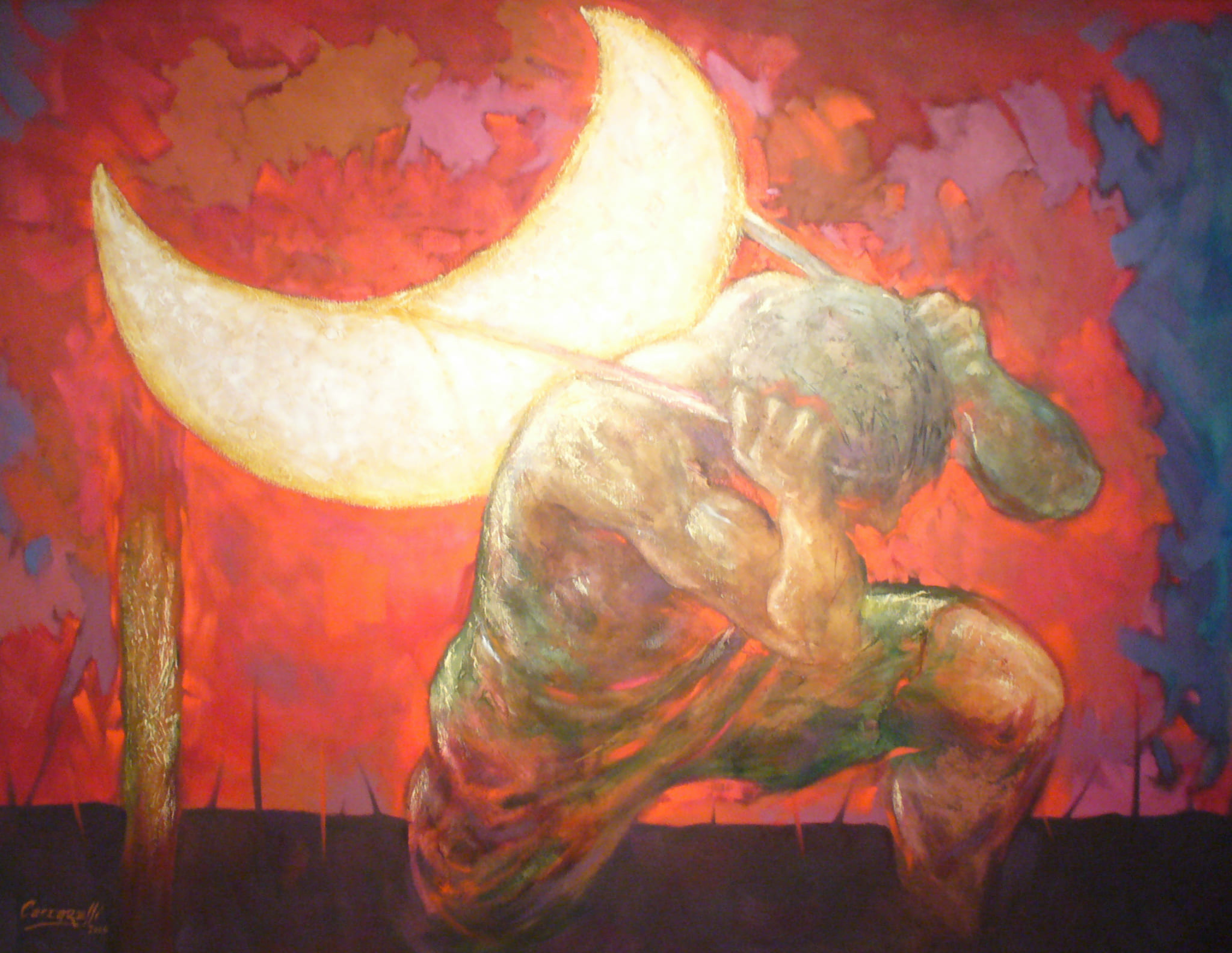
Gino Ceccarelli, Chauchero, a powerful reflection on the human cost of the Amazon’s rubber boom. The figure, bent beneath the weight of both burden and history, embodies endurance and pain, carrying the memory of those who were exploited in its name.
Historical Context and Influences
The development of contemporary Amazonian painting has been profoundly shaped by its colonial past and by the lasting impact of extractive economies — from the rubber boom to deforestation, oil drilling, and mineral exploitation. At the same time, a continuous exchange with diverse cultural influences has enriched and transformed this art.
In its early stages, many artists approached the Amazon from a documentary perspective, depicting local flora, fauna, and daily life primarily through the eyes of outsiders.
Peruvian painter César Calvo de Araújo was a pioneer of this approach, coining the term “Amazonian Art” in the 1940s. In 1963, a body of work under this designation was exhibited in a museum for the first time.
Over time, artists began to develop a more personal and critical vision, influenced by European academic traditions, modernist currents, and the global art scene. They no longer painted the Amazon as an exotic landscape, but as a living world — translating its myths, legends, and invisible realities into visual language.Through this shift, Amazonian art moved from documentation to revelation, offering a deeper and more introspective vision of its culture.

Graciela Arias Salazar, Magia, A vision where the forest dreams itself alive — the turtle carries the house of memory, while the cosmic serpent illuminates the invisible threads that unite water, earth, and spirit.
Shared Foundations
The deepest connection between these two movements lies in the Amazon itself.
The rainforest — with its intricate network of rivers, boundless biodiversity, and its ever-present world of magic, myths, and legends — remains an inexhaustible source of inspiration for both Indigenous and non-Indigenous artists.
Themes of resilience, survival, and the mythical world, along with the intimate relationship between humans, the earth, and the cosmos, are central to both art forms. They form a shared symbolic language — even when spoken in different dialects.
Each, in its own way, reveals a distinct Amazonian identity — one that sets the region’s artists apart culturally from those in the rest of the country, and indeed, the world.

Gino Ceccarelli, “La Yara”, A mythical being that symbolizes the irresistible yet perilous beauty of the Amazon rainforest, a place of immense bounty and wonder, where enchantment meets danger. This illustrates how the Amazon’s ancient myths and beliefs remain alive today.
Amazonian Art: Between Tradition and Intercultural Exchange
Some Amazonian artists depict the vastness and striking beauty of the jungle — the labyrinth of rivers, the bustling cities of Iquitos and Pucallpa, and the quiet rhythm of life in riverside communities. Their landscapes range from meticulous realism to lyrical abstraction, capturing the wild energy of the forest and the ceaseless flow of its waters.
Social themes also play a central role. Many artists address urbanization, poverty, migration, and environmental degradation, often from personal experience. While not all of these works focus on spiritual transformation, they reveal the tangible impact of industrial pollution, deforestation, and social inequality on local communities.
The daily lives of urban dwellers, fishermen, rubber tappers, and other local communities provide a wealth of motifs that reflect the complex social fabric of the region. Some artists deliberately explore the blending of cultural influences, weaving together European, North American, and Indigenous elements — a reflection of Amazonia’s layered and evolving identity.
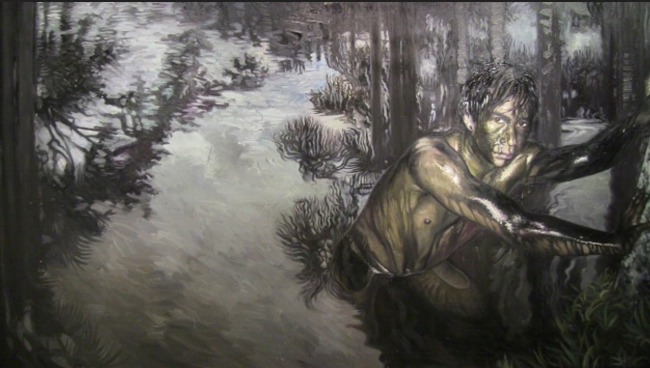
Christian Bendayán’s “Man in the River” depicts a figure floating in oil-contaminated waters — a haunting image of silent resistance, struggle, and survival in the Amazon’s depths.
Forms, Visions, and Alternate Realities in the Amazon
Contemporary Amazonian art stands out for its remarkable stylistic and technical diversity, reflecting an ongoing dialogue between its creators and a wide spectrum of expressive languages.
This artistic range extends from academic realism to expressionist, surrealist, abstract, and urban approaches—revealing the richness and plurality of the region’s creative landscape.
The surrounding environment serves as a fundamental source of inspiration. Its intense colors and radiant light inform a palette directly drawn from the forest’s exuberance and the flow of its rivers. Yet many artists move beyond naturalistic representation, venturing into bold chromatic contrasts and unconventional forms. In doing so, they face formal challenges that transcend direct observation, seeking instead to convey sensations, memories, and inner narratives.
These artists also give voice to alternate visions and realities that coexist with daily life in the Amazon. Through ancestral symbols, reimagined myths, and contemporary visual languages, their works invite us to enter worlds where the spiritual and the material become one.
In this way, their exploration of the unseen expands the very boundaries of art, opening spaces for the dreamlike, the mythological, and the symbolic.
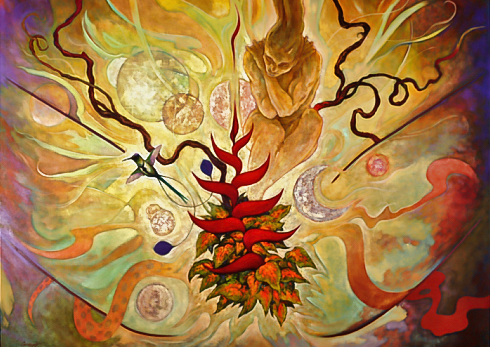
Gino Ceccarelli, La Creación, a vision of birth and renewal, where life emerges from mystical wonder and the Amazon reveals its sacred origin — a fusion of cosmos, spirit, and nature.
Two Visions—One Amazon
Distinct motivations and characteristics may define the two currents of Amazonian painting, but they do not exist in isolation. They share not only the same geographic territory but also increasingly a common cultural space. Amazonian art, in particular, transcends the barriers of origin and race, uniting its inhabitants in a shared vision and identity.
However, non-indigenous Amazonian artists bring their own cultural background. In their works, echoes of other cosmogonies resonate, with diverse explanations of the world, infinity, origins, and the vicissitudes of existence. They cannot—and should not—separate themselves from academic training, from acquired technique, or from the rationality that guides their compositions, even when addressing the symbolic or the mystical.
Even what emerges from the most profound experiences—from those abysses that inhabit us and hide so easily—is always filtered through the lens of individual and collective experience.
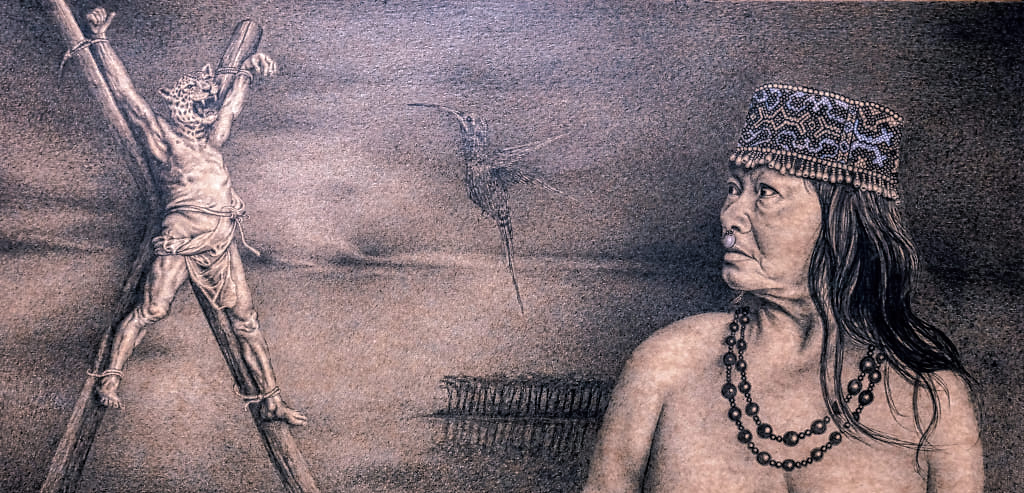
Miguel Vilca Vargas, Las tres mitades de un delirio, a drawing of haunting beauty and spiritual depth. Between myth and memory, the scene evokes an inner dialogue between sacrifice and vision, the sacred and the human — a world torn between its ancestral roots and contemporary dissonance. Vilca’s work embodies that tension: faith and despair, nature and spirit, life and transformation — revealing the raw pulse of the Amazonian soul.
A Living Dialogue
It is in the fertile tension between the ancient and the contemporary,
the material and the spiritual, that Amazonian art discovers its vital pulse.
This ongoing dialogue does not seek resolution,
but rather generates the very richness and complexity that define it,
a living testament to a culture in constant, creative becoming.
This dialogue creates a path that unites two ways of seeing the world.
It is in this very dialogue that the soul of Amazonian art finds its voice,
revealing its true richness and profound complexity, and guiding us toward
a deeper understanding of the Amazon… and of ourselves.
To learn more, read:
A Note on Terminology
The terms used to describe art from the Amazon vary and sometimes intersect. While some works are included under the broader term Contemporary Amazonian Art, or simply „Amazonian Art.“ Many creators from Indigenous communities define their work specifically as „Indigenous Contemporary Art“, emphasizing its origin within their own traditions and worldviews.
In this text, I will use both this specific term and the more geographically descriptive „Indigenous Amazonian Art“, aiming to respect the artists’ self-identification while also situating their work within the unique cultural landscape that inspires it.
Both names are used with equal respect, recognizing that what unites these artists is far stronger than what distinguishes them — a creative dialogue between heritage and transformation, between the forest’s memory and the contemporary world.
